Original title: "Still bullish? Or are we in the "wealth destruction" phase now?"
By Michael Nadeau
Compiled by: TechFlow
Hello readers, we ran some polls last week on X and LinkedIn, and many of you wanted to see more data/analysis on the current cycle.
So, our focus this week will be to answer these questions: Will there still be a bull market for cryptocurrencies in 2025? Why am I still pessimistic despite all the positive factors? And how should we think dialectically about the state of the cycle?
Let's go!
Bearish view
Before I get into analyzing on-chain data, I want to share some qualitative analysis of how we think about cryptocurrency cycles.
Early bull market stage
It is approximately the period from January 2023 to October 2023.
This was the period when the market bottomed out after the FTX crash. It was a very quiet period (low trading volume, crypto twitter was almost silent). Then the market started to rise again.
The price of Bitcoin rose from about $16,500 to $33,000.
However, no one calls this stage a bull market. In the "early bull market" stage, most market participants are still on the sidelines.
Wealth creation stage
This is approximately the period from November 2023 to March 2024.
During this phase, we saw a sharp rise in coin prices and a significant wealth-creating effect. For example, SOL rose from $20 to $200. Jito's airdrop (December 2023) created an amazing wealth effect within the Solana ecosystem and repriced Solana's DeFi projects (such as Pyth, Marinade, Raydium, Orca, etc.). The VC market also peaked during this phase.
Bitcoin went from $33,000 to $72,000. Ethereum went from $1,500 to $3,600.
Bonk’s market cap increased from $90 million to $2.4 billion (26 times). WIF’s market cap increased from $60 million to $4.5 billion (75 times). This phase also sowed the seeds for a larger “Memecoin season”.
But even so, this is still a relatively “quiet” time. Your “regular friends” probably haven’t started asking you questions about cryptocurrency yet.
Wealth distribution stage
This is approximately the period from March 2024 to January 2025.
This phase is "peak attention". We often see "WAGMI" (We're All Gonna Make It), rapid rotation, new hot spots (although they quickly fade), and blind investments that pay off. Celebrities and other "crypto passers-by" often enter the market at this stage. This phase may see sensational news such as "Tesla buys Bitcoin" or "Bitcoin strategic reserve".
Why?
Because new investors will enter the market based on this news. They worry that they have "missed the party".
This was the second wave of the “Memecoin Season”, which then evolved into the “AI Agent Season”. During this phase, the market turned a blind eye to many obviously problematic behaviors. No one wanted to point out the problems because everyone was making money.
Then we come to today's situation.
Wealth destruction stage
We believe we reached this stage shortly after Trump took office.
This is the period the market enters immediately after a sell-off at the top. The catalyst for the bull run is a thing of the past. Seemingly positive news is triggering bearish price action.
In the current market environment, political actions regarding the “Bitcoin Strategic Reserve” have not had an impact on the market - this is an important signal. At this stage, the market's rebound often encounters key resistance levels and ultimately fails (we saw the market's reaction to Trump's tweet on crypto reserves last week).
We pay extra attention to some signals during the "wealth destruction" phase:
- Liquidations and “panic” events that disrupt markets but still fail to fully sober them up — we saw something similar with the DeepSeek AI panic and tariff uncertainty.
- Investors are still "illusory". We saw a lot of discussion today about the decline of the US dollar and the growth of global M2 (broad money) (more on this later in the report).
- "Speculators" enter the market. More people PM us "check out their project", more ads flow through the market, well-funded projects at conferences spend money and more PvP. And the whole industry exudes a more "dirty" atmosphere. During the "wealth destruction", bad actors begin to show their faces.
In this phase, hidden problems gradually emerge - usually after liquidation. The last cycle started with Terra Luna, which then led to the collapse of Three Arrows Capital. This was followed by the bankruptcy of BlockFi, Celsius, FTX, etc., and eventually led to the collapse of Genesis and the sale of CoinDesk.
We haven’t seen any blow-ups yet. This cycle should see fewer blow-ups — simply because there are fewer CeFi companies, which means that when the market officially bottoms, the lows are likely to be higher.
Where did the explosion come from?
No one knows, but I think there are some "suspects" to keep an eye on:
- Exchanges: Be aware of hidden leverage and/or potential fraud in some overseas “B- and C-grade” exchanges.
- Stablecoins: We are watching Ethena/USDe - which currently has close to $5.5 billion worth of stablecoins in circulation. It maintains its peg and earns yield through cash-futures arbitrage (holding spot, shorting futures) - a model that was the main source of leverage in the last cycle (via Grayscale). Ethena's reliance on centralized exchanges adds additional counterparty risk. In addition, MakerDAO also invests part of its reserves in USDe, further increasing the chain risk in DeFi.
- Protocols: Be wary of frequent hacker attacks and potential liquidation chain reactions due to crypto asset collateralization on platforms such as Aave - Aave currently still has over $11 billion in active loans (although it has fallen from a peak of $15 billion).
- Strategy: We think Strategy has done a good job of prudently managing debt, with most of its debt being long-term unsecured debt or convertible bonds (BTC holdings will not trigger margin calls). In addition, they were able to withstand a 75% drop in BTC prices in the last cycle. But having said that, if BTC prices were to fall significantly, it could force Saylor to sell a large amount of BTC at the worst possible time.
The best time to re-enter the market is at the end of the wealth destruction phase. We believe that time has not yet arrived.
Bearish data
Decentralized Exchange (DEX) Trading Volume
Trading volume on the Solana decentralized exchange has dropped by 80% from its peak after Trump launched his Memecoin. At the same time, the number of active independent traders has also dropped by more than 50%. This shows us that speculative enthusiasm in the market is weakening.
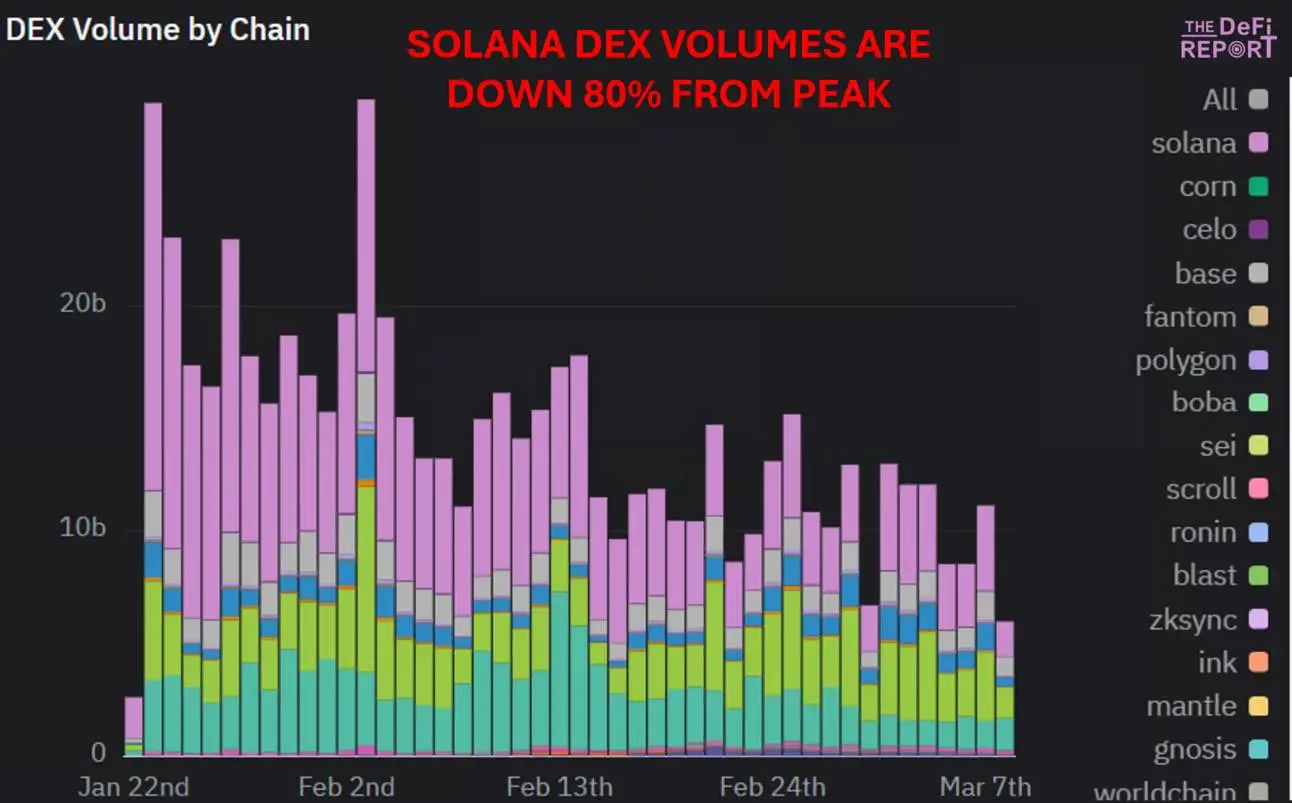
Data: The DeFi Report, Dune
Token issuance
Token issuance on Solana is down 72% from its peak. Despite this, the chain is still seeing over 20,000 tokens being created every day.
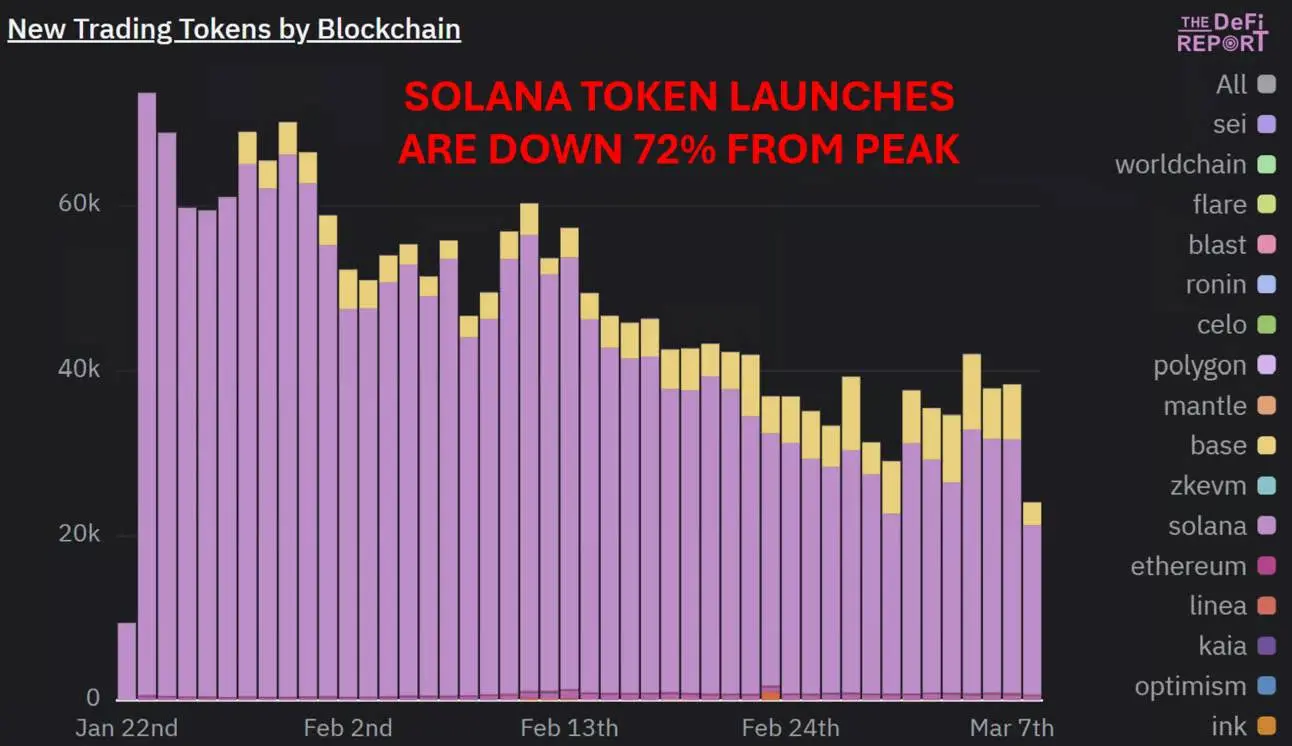
Data: The DeFi Report, Dune
BTC long-term holder MVRV ratio
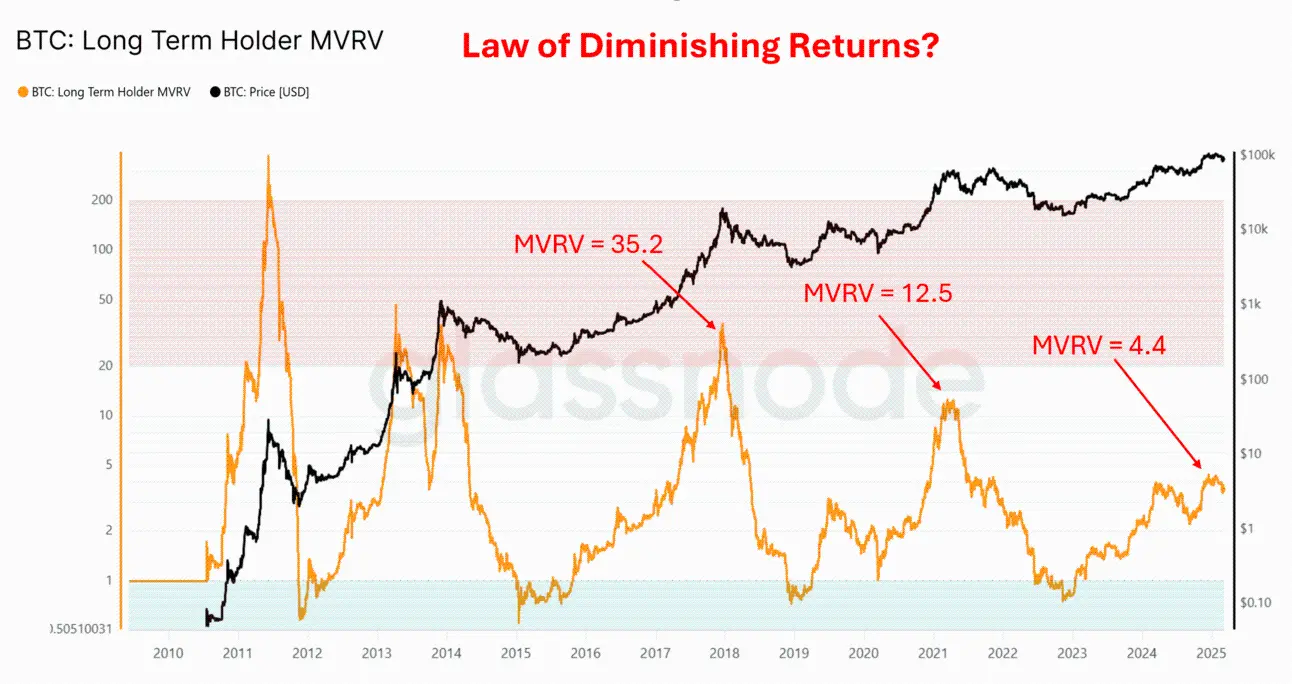
Data: Glassnode
The MVRV (“smart money” in Bitcoin) of long-term holders of Bitcoin peaked at 4.4 in December last year. This is only 35% of the 2021 cycle peak of 12.5, which in turn was 35% of the 2017 cycle peak.
Bitcoin rose about 80 times from low to high in the 2017 cycle, about 20 times in the 2021 cycle, and about 6.6 times in the current cycle.
The realized price of Bitcoin (i.e., the average cost basis of all circulating Bitcoin) peaked at $5,403 in the 2017 cycle, which is 15.1 times higher than the peak of the 2013 cycle; it peaked at $24,530 in the 2021 cycle, which is 4.5 times higher than the peak of the 2017 cycle. Today's realized price is $43,240, which is 1.7 times the peak of the 2021 cycle.
in conclusion
- From each of the above data points, it can be observed that the peaks of different periods show a symmetrical decrease. These data clearly show that the law of diminishing returns does exist.
- Today Bitcoin is a $1.7 trillion asset. No matter how bullish the news, investors should not expect to see sustained parabolic growth as they have in the past — the amount of money required to drive the asset higher at this point is simply too great.
- When Bitcoin loses momentum, the rest of the coins in the market also get hammered.
- Speculative enthusiasm for Solana is waning, and considering that 61% of DEX volume so far this year involves meme coins, we are concerned that Solana's "recovery story" is built on a "house of cards." In addition, less than 1% of Solana users have contributed more than 95% of gas fees in the past 30 days. This is worrying because it suggests that a small group of Solana users (the "big fish" or whales) are preying on other users (the "small fish" or retail investors). Therefore, if the "small fish" get tired of losing money and choose to temporarily exit (which we think they are doing), we may see Solana's fundamentals deteriorate rapidly.
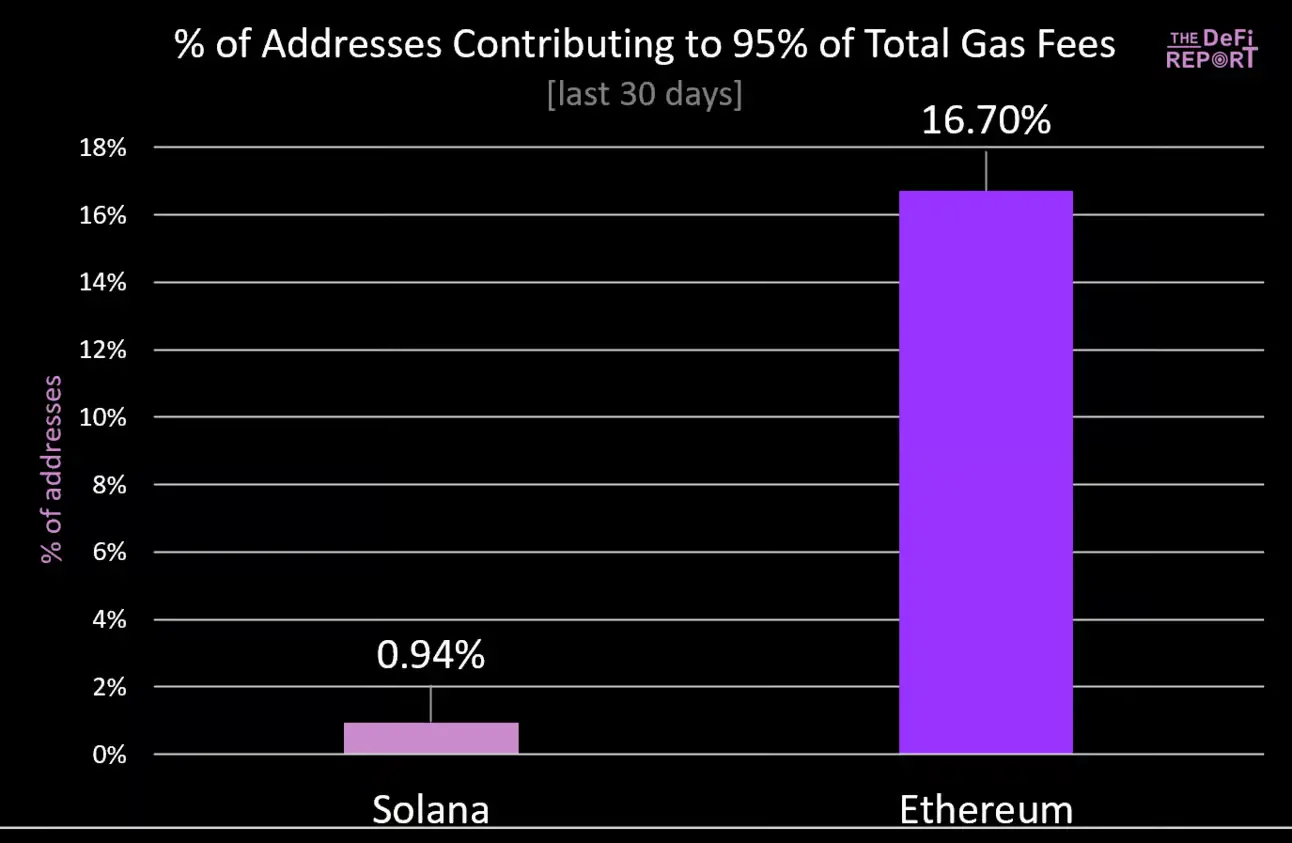
Data: The DeFi Report, Dune (base + priority fees + Jito tips on Solana)
- Long-term Bitcoin holders have taken profits twice in the past year. Their realized price (i.e., cost basis) is currently around $25,000. Short-term holders who bought at the highs are now losing money with an average cost basis of $92,000. We believe that these short-term holders may continue to sell at lower highs as the market realizes that the top of Bitcoin has occurred at $109,000.
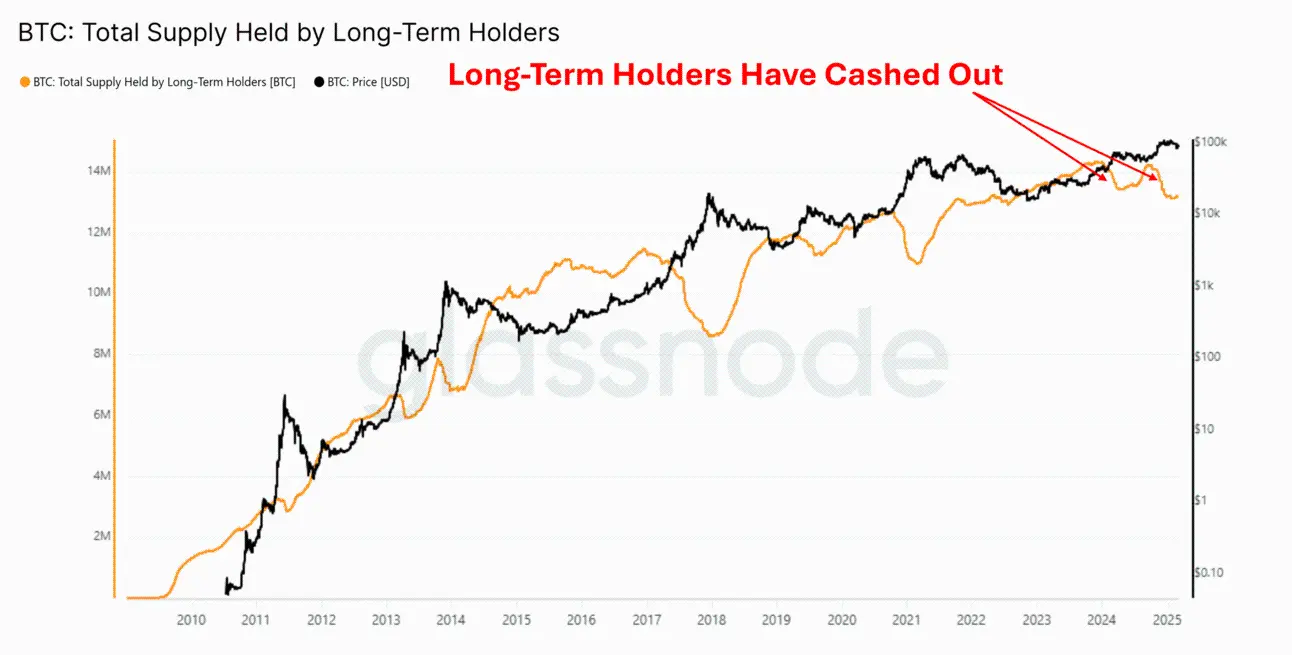
Data: Glassnode
When all the information is laid out like this, we find it undeniable that the “typical” cycle has been completed and it is not some so-called “law” that is at work.
In our view, the best way to process this information is to accept the reality and assign a probability to the possibility that the cycle has peaked. We think this probability is clearly over 50%.
After completing the fundamental analysis, we try to find holes in our thesis and stress test our views.
Let’s get started.
Bullish view
I still see a fair amount of opposition to the bears’ view in the market and the bulls will not lay down their arms easily.
This begs the question: Is the bullish view further evidence that we have entered the “wealth destruction phase”? Or are we being too bearish and ignoring the possibility of another leg higher?
In this section, we will sort out some of the "bullish views" observed.
Global M2/Liquidity
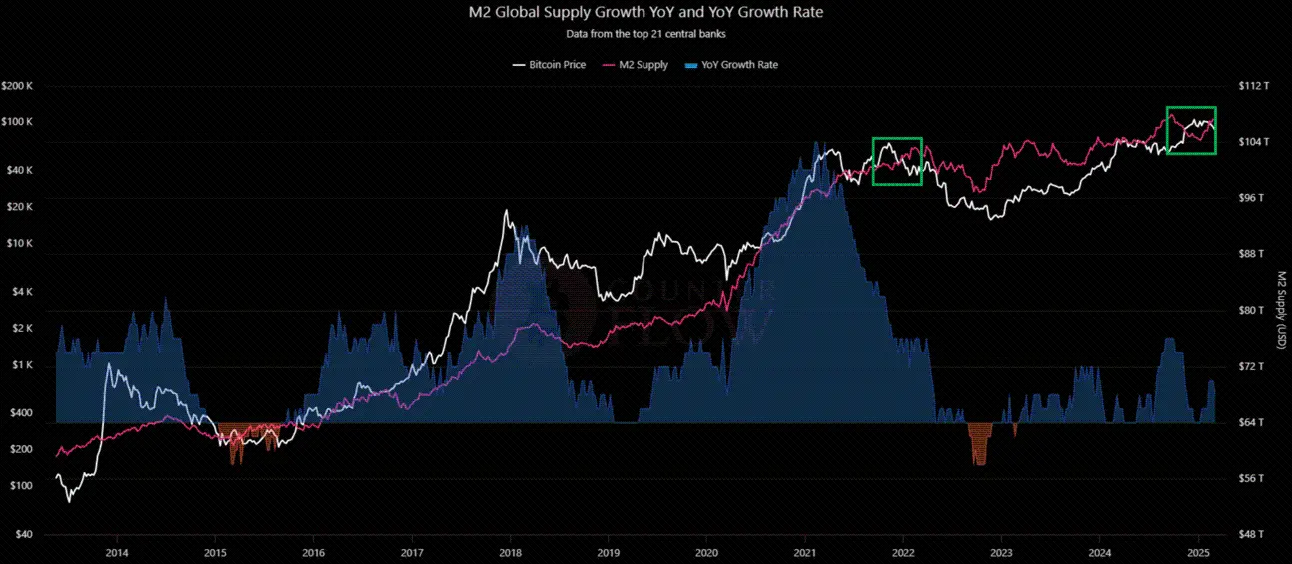
Data: Bitcoin Counter Flow
The green box on the right shows that when global M2 started to rise, BTC was falling. Some people pointed this out and mentioned the correlation between BTC and M2, and how BTC usually has a 2 to 3 month lag in responding to changes in M2.
The green box on the left shows that a similar dynamic occurred at the end of the previous cycle: M2 rose while BTC fell. In fact, M2 did not peak until early April 2022 - 5 months later than BTC peaked.
Since mid-January, global M2 has grown by 1.87%, mainly due to central banks' shift from tightening to easing policies.
This is beneficial for liquidity conditions.
However, we also need to consider the following issues:
- What is driving the growth in M2? We think it is mainly from the decline in the US dollar (down 4% since February 28th!), which means that foreign currencies denominated in US dollars have increased, thus driving global M2 growth. In addition, the reverse repo facility was recently drained and China is also stimulating its economy through loose policies.
- Will this trend continue? We believe that the dollar will continue to fall as investors move money overseas, but the pace of decline in the coming weeks may not be as rapid as it has been recently. We expect China to continue to ease policy against the backdrop of a lower dollar. However, the Fed may not ease in the short term as they have stated that reserves remain "ample." In addition, we believe the Fed is still concerned about inflation.
- How do liquidity conditions compare to last year? We believe that liquidity conditions should be considered headwinds compared to last year. Remember, it’s the rate of change, not just nominal growth, that matters. We strongly believe that the Fed and Treasury moved the market last year through “shadow liquidity” — i.e., “not-QE” (QE) and “not Yield Curve Control” (YCCC) — to help Biden/Harris’ reelection. The removal of these policies has had a significant impact on the rate of change, according to Michael Howell of Cross Border Capital.
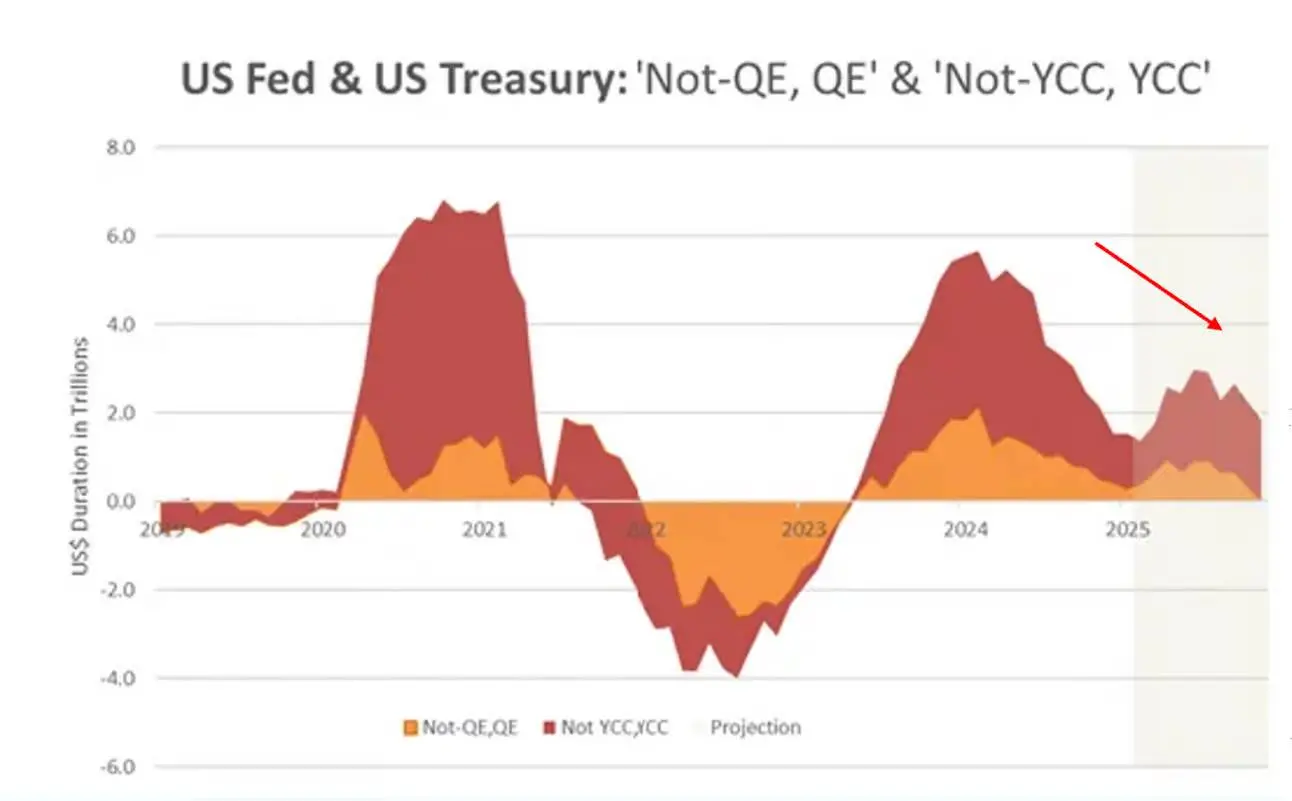
Data: Cross Border Capital
It is estimated that the above-mentioned “secret stimulus” added $5.7 trillion to the US market at the beginning of 24. This was achieved by exhausting reverse repo + issuing new bonds in advance in the bill.
Finally, we think investors should pay close attention to what Treasury Secretary Bessent said in a CNBC interview last week: "The markets and the economy have become addicted. We have become dependent on this kind of government spending. It's going to take a weaning period. It's going to take a weaning period."
Business Cycle/ISM
We have previously noted that the ISM data indicated the start of a new business cycle. We have also recorded strong data on capital expenditure (Capex) purchases and small business confidence. We believe these data are real, but also clearly show that growth is slowing. The data we observed last month may have been distorted by some manufacturers "front-loading" in anticipation of tariffs. Since then, we have seen some signs of weakness in the services and new orders data, and the manufacturing PMI reading in February was 50.3, down from 50.9 in January.
Strategic Bitcoin Reserve
Until last Friday, we continued to see crypto natives holding out hope for discussions regarding strategic cryptocurrency/Bitcoin reserves — despite the market having shrugged off such news multiple times over the past 6 weeks.
I think we can now agree that this was a “buy the expectations, sell the news” event.
The flaws of “cyclical thinking”?
We should also acknowledge that the current “cycle” behaves differently than past cycles. For example:
- For the first time, BTC hit a new all-time high before a halving.
- This cycle is shorter, with only two years of bull market.
- The “altcoin season” has behaved very differently, with Bitcoin dominance having been rising in a step-by-step manner since the beginning of 2023.
- Bitcoin is now fully integrated into the financial system and has the backing of the U.S. government.
If “cyclical thinking” is flawed, then perhaps we have not peaked yet. Instead, we may simply be entering a pause/correction/consolidation phase before the next leg higher, rather than a one-year bear market where prices could fall 75%-80% as in the past.
We believe the cycle is evolving. However, we still expect the bear market to take perhaps 9 to 12 months to fully unfold.
Summarize
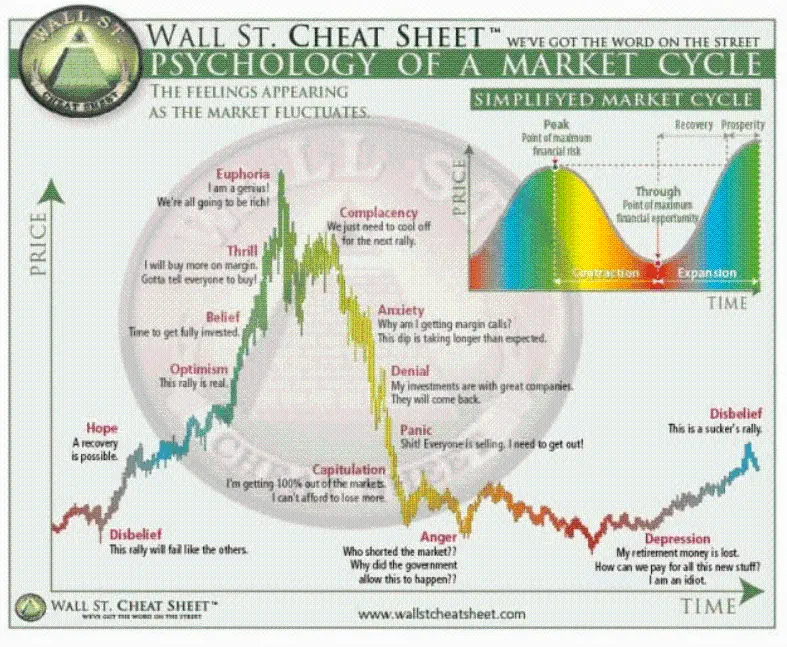
To summarize our views:
- We believe that we are currently in the “complacency” phase of the cycle shown in the chart above.
- All of the bullish catalysts that could be identified a few years ago have already materialized.
- The economy may be heading for a recession. We think the Trump administration is being very clear. They are essentially telling us that the economy needs a "de-escalation period". We should trust their words. This is very similar to what happened in early 2022 when Powell said "pain is coming" before raising rates. Our current thinking is that crypto is the canary in the coal mine. Traditional financial markets will slowly fall/shock in tandem.
- Given the extremely bearish sentiment, we could see the market rebound towards BTC’s low $90k range in the short term. However, we believe such a rally would be suppressed by intense selling – which could kill any hopes of resuming the bull market structure.
- As always, we remain open to the possibility that we may be wrong. Our analysis is based on the information we currently have. We will update our views as new information becomes available.
What would make us bullish again? We would focus on the following:
- Reversal of austerity/efforts of DOGE (Department of Government Efficiency).
- The Fed’s aggressive rate cuts/quantitative easing (QE).
- A massive influx of global liquidity driven by the Federal Reserve (not just China).
- Major correction/capitulation in the S&P 500/Nasdaq.
One of our concerns is that the bear market view is becoming a consensus view. That gives us some concerns. But for now we need to stick with all the other factors - because there are all signs that the cycle top has been formed and the bear market is coming.
Of course, there are many reasons to be bullish in the long term.
Cryptocurrency has truly reached its “tipping point” period. Now is finally the time to rebuild the financial system on top of public blockchains.
Not to mention, we love bear markets. When the tide recedes, the noise from past cycles becomes easier to sort out, leaving behind the real signals - which will prepare us well for the next bull market.
This is when we do all our best work and when we create the most value for our readers.












